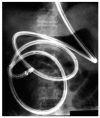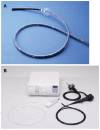Current status of device-assisted enteroscopy: Technical matters, indication, limits and complications
- PMID: 23189216
- PMCID: PMC3506955
- DOI: 10.4253/wjge.v4.i10.453
Current status of device-assisted enteroscopy: Technical matters, indication, limits and complications
Abstract
Enteroscopy, defined as direct visualization of the small bowel with the use of a fiberoptic or capsule endoscopy, has progressed considerably over the past several years. The need for endoscopic access to improve diagnosis and treatment of small bowel disease has led to the development of novel technologies one of which is non-invasive, the video capsule, and a type of invasive technique, the device-assisted enteroscopy. In particular, the device-assisted enteroscopy consists then of three different types of instruments all able to allow, in skilled hands, to display partially or throughout its extension (if necessary) the small intestine. Newer devices, double balloon, single balloon and spiral endoscopy, are just entering clinical use. The aim of this article is to review recent advances in small bowel enteroscopy, focusing on indications, modifications to improve imaging and techniques, pitfalls, and clinical applications of the new instruments. With new technologies, the trials and tribulations of learning new endoscopic skills and determining their role in the diagnosis and treatment of small bowel disease come. Identification of small bowel lesions has dramatically improved. Studies are underway to determine the best strategy to apply new enteroscopy technologies for the diagnosis and management of small bowel disease, particularly obscure bleeding. Vascular malformations such as angiectasis and small bowel neoplasms as adenocarcinoma or gastrointestinal stromal tumors. Complete enteroscopy of the small bowel is now possible. However, because of the length of the small bowel, endoscopic examination and therapeutic maneuvers require significant skill, radiological assistance, the use of deep sedation with the assistance of the anesthetist. Prospective randomized studies are needed to guide diagnostic testing and therapy with these new endoscopic techniques.
Keywords: Device-assisted enteroscopy; Double balloon; Single balloon; Spiral endoscopy.
Figures
References
-
- Sugano KYH, Kita H. Double-balloon endoscopy: theory and practice. New York: Springer; 2006.
-
- Yamamoto H, Sekine Y, Sato Y, Higashizawa T, Miyata T, Iino S, Ido K, Sugano K. Total enteroscopy with a nonsurgical steerable double-balloon method. Gastrointest Endosc. 2001;53:216–220. - PubMed
-
- Mönkemüller K, Fry LC, Bellutti M, Malfertheiner P. Balloon-assisted enteroscopy: unifying double-balloon and single-balloon enteroscopy. Endoscopy. 2008;40:537; author reply 539. - PubMed
-
- Nakamura M, Niwa Y, Ohmiya N, Miyahara R, Ohashi A, Itoh A, Hirooka Y, Goto H. Preliminary comparison of capsule endoscopy and double-balloon enteroscopy in patients with suspected small-bowel bleeding. Endoscopy. 2006;38:59–66. - PubMed
-
- Heine GD, Hadithi M, Groenen MJ, Kuipers EJ, Jacobs MA, Mulder CJ. Double-balloon enteroscopy: indications, diagnostic yield, and complications in a series of 275 patients with suspected small-bowel disease. Endoscopy. 2006;38:42–48. - PubMed
LinkOut - more resources
Full Text Sources
Miscellaneous



